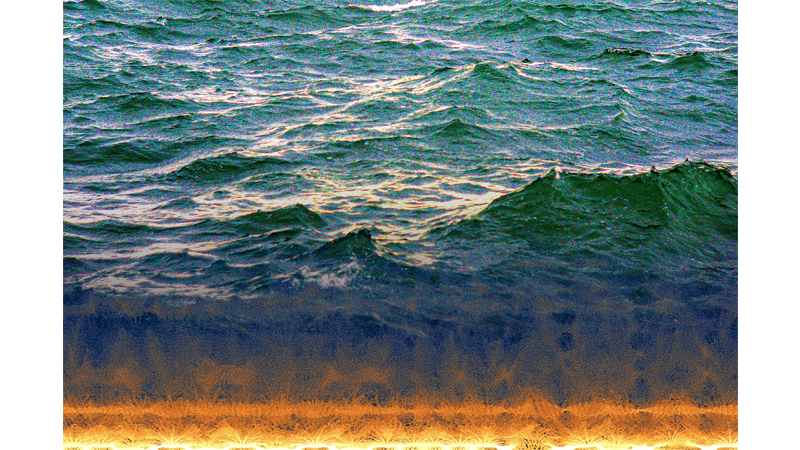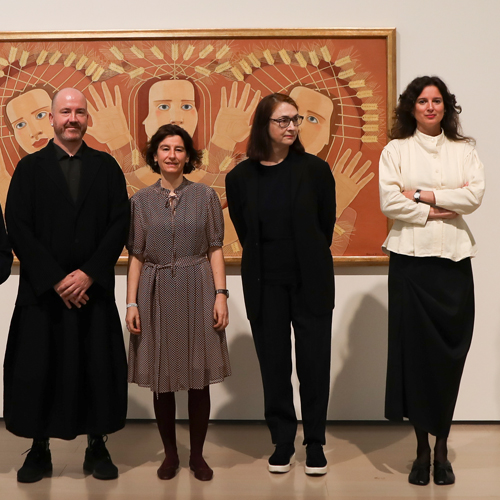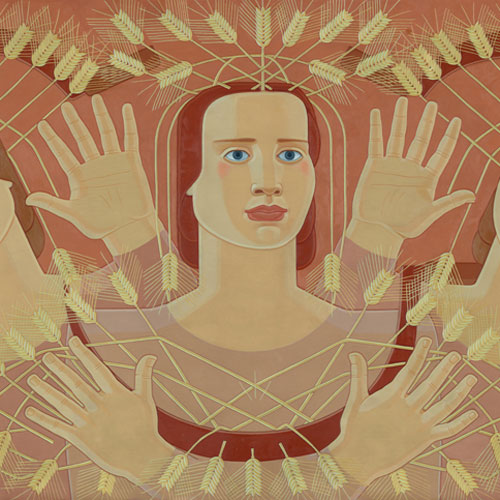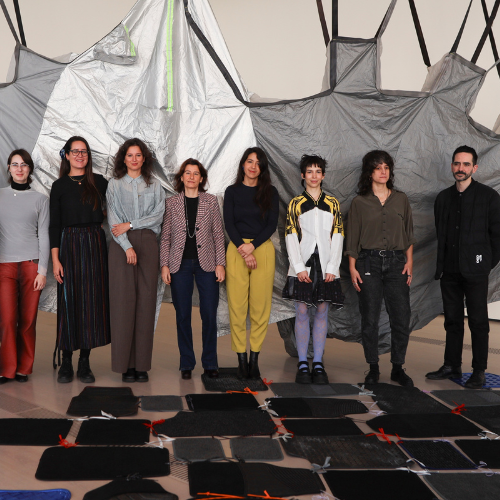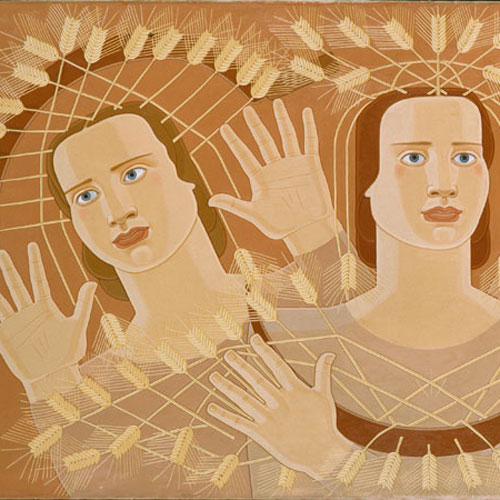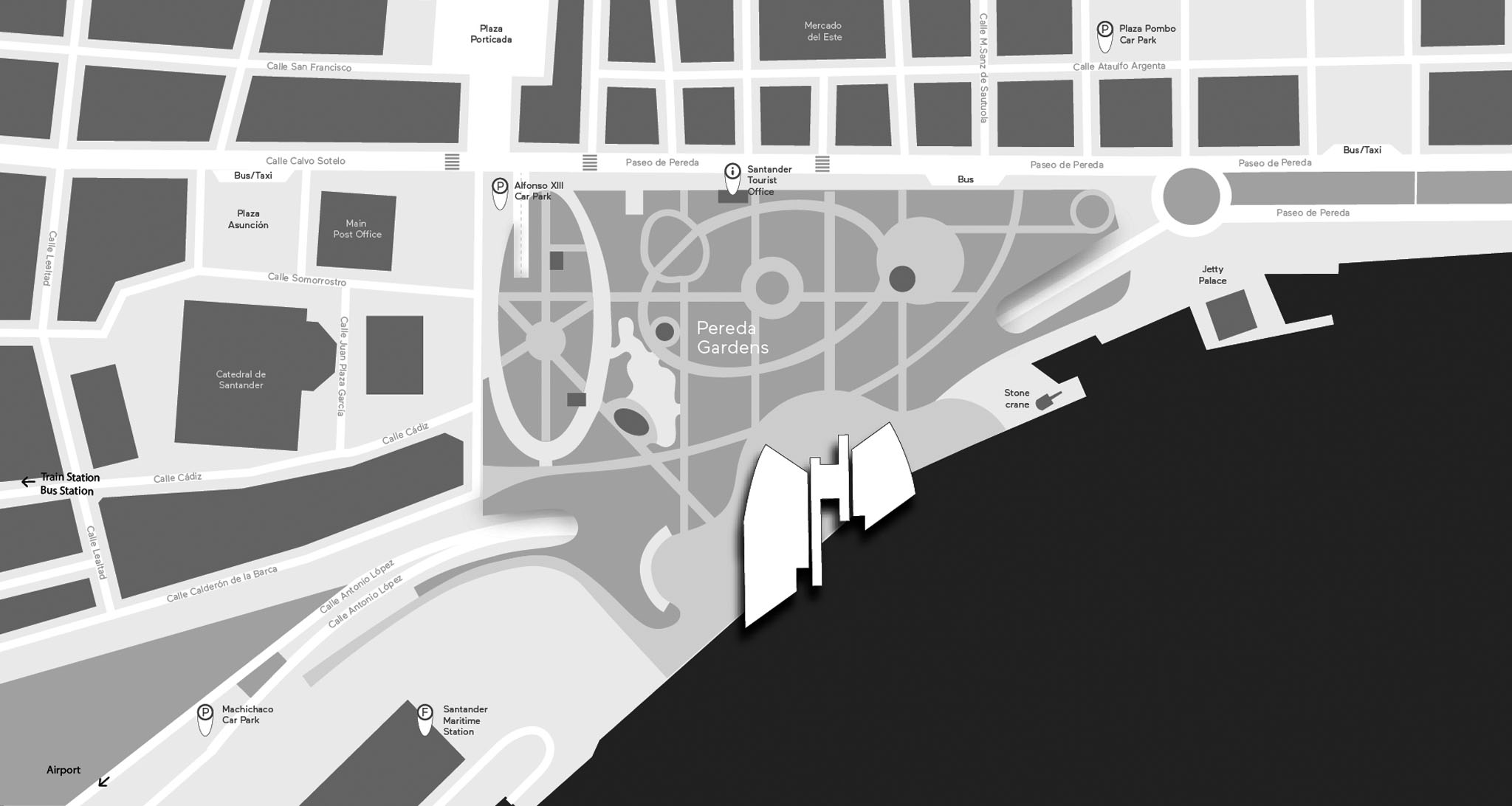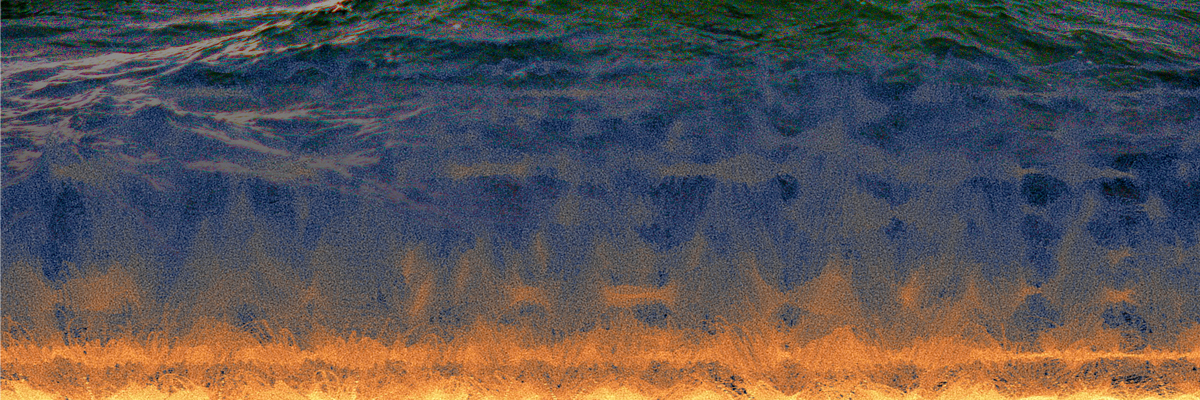
CENTRO BOTÍN PRESENTS ‘ENREDOS II: NUNO DA LUZ’
- Running from 31 May to 19 October 2025, the show marks the second chapter of the exhibition programme Enredos, through which Centro Botín continues to support artists awarded an Art Grant by Fundación Botín.
- Curated by Nuno da Luz – a 2015 Art Grant recipient – in collaboration with Bárbara Rodríguez Muñoz, Director of Exhibitions and the Collections at Centro Botín, the exhibition transforms the building into a resonant acoustic body, where Nuno’s sound installations coexist with selected works from the Fundación Botín collection.
- The exhibition will be accompanied by a catalogue co-published with Mousse Publishing, featuring images from the show alongside photographs of Centro Botín’s surroundings captured by Nuno during his ambient sound recordings. The catalogue will also include texts by sound historian and University of Oxford professor Gascia Ouzounian, as well as by Alejandro Alonso Díaz, curator and director of fluent, a non–profit arts organisation based in Santander. Additionally, it will feature an in-depth interview between Bárbara Rodríguez Muñoz and the artist.
Centro Botín presents Enredos II: Nuno da Luz, the second chapter of the exhibition programme (Enredos) with which Centro Botín invites mid-career artists who have benefited from an Art Grant from the Fundación Botín to reconnect with the collection, the spaces, the teams and visitors of Fundación Botín’s art centre in Santander. Open to the public from 31 May to 19 October 2025, this exhibition transforms the building, designed by Pritzker Prize winner Renzo Piano, into a reverberating acoustic body, where Nuno’s works coexist with a selection of pieces from Fundación Botín’s collection. In this way, Nuno amplifies the resonant frequencies of the waves, currents and winds felt in the Bay of Santander, entwining them with the oscillations of Centro Botín’s building as well as the works of Javi Arce, Katinka Bock, June Crespo & Madi Barber, Tacita Dean, Eva Fàbregas, Asier Mendizabal, Damián Ortega and Jorge Satorre.
Nuno da Luz (Lisbon, 1984) makes what could be defined as ‘environmental artwork’ that, aside from focusing on environmental phenomena such as the weather, the tides, the wind or climate change, translates the intensities, rhythms and patterns of these phenomena into sounds that transform spaces and architecture. This project arose from Nuno’s interest in environmental sound sources and their potential for vibrational transformation, which involves all bodies – be they human, non-human, organic or artificial – through ‘sympathetic resonance’.
The exhibition will present two new sound installations by the artist, produced by Fundación Botín, which will continue exploring sound as a means of revealing architecture as a dynamic and resonant entity, which is also the case with Centro Botin’s building which, supported by pillars, has a certain elasticity, and vibrates in perceptible and imperceptible ways. Sound is also a force in these new works, bringing the atmospheric conditions of the Bay of Santander inside the exhibition hall. The Metropolitan Sonic Disposal Service converts environmental data from the building’s immediate surroundings into sound and vibrations through the walls of the exhibition hall. This data, provided by the Oceanographic Centre of Santander (Spanish Institute of Oceanography, IEO-CSIC), includes wave activity, currents, wind, and water and air temperature from the oceanic water off Santander, obtained by the Augusto González de Linares buoy anchored down at 2,840 metres. At the same time, they amplify the building’s own vibrations, extending and intensifying its intrinsic energies.
Collected Airs, produced by Fundación Botín with the generous support of the Portuguese Embassy in Spain, unites different improvisations of artists and musicians from the Portuguese scene who form an essential part of the work. This work has been possible thanks to the collaboration in the framework of the Portugal-Spain joint cultural programme: 50 Years of Culture and Democracy, which the Ministries of Foreign Affairs and Ministry of Culture of both countries participate in, alongside other institutions like the Instituto Camões and GEPAC. Nuno, for this new sound installation, has created a set of reverberation units (large suspended steel plates, equipped with a transducer that converts audio signals into physical vibration). Although this instrument is traditionally used in the recording studio to add spatial depth to the recordings, da Luz reimagines this reverberation unit as an instrument, a sculptural presence that interacts with its environment and functions as a kind of timekeeper. In addition, Nuno has invited different performers from the Portuguese music scene to improvise and play with each reverberation unit. Each musician’s recording is played back through their assigned plate in the exhibition space. The plates do not only transmit these performances; they also resonate with a live feed of ambient sounds from outside the Centro Botín. In this way, each plate serves not only as a musical record but also as a “timestamp,” preserving the traces of a particular moment – its shifting weather and the unpredictable events that compose it.
‘I want to bring many different vibrations that are happening outside – whether in the air or underwater vibrations – into the space, filtering and resonating them through the building’s walls, with hidden and not-so-hidden transducers’, the artist says, ‘that way, the building begins to resemble what is happening outside, but at different scales’. For her part, Bárbara Rodríguez Muñoz, Director of Exhibitions and the Collections at Centro Botín, and co-curator of this show with Da Luz, affirms that, ‘It has been wonderful accompanying Nuno through this process of rediscovery of the collection’s works, and of the building itself, through his sensitivity to the acoustic and the environmental. Instead of favouring a visual encounter with art, Nuno proposes an affective encounter that connects the collection to the building and its natural surroundings through different resonant frequencies’.
The exhibition is accompanied by a catalogue, co-published with Mousse Publishing and illustrated with images from the exhibition and photographs of Centro Botín’s surroundings taken by Nuno while he recorded the ambient sound. The book opens with an essay from sound historian and professor at the University of Oxford, Gascia Ouzounian, which articulates Nuno’s ecological and environmental practice and how, through his work, the energies of one environment shape another, revealing the interconnection of seemingly distinct places. It also features a text by Alejandro Alonso Díaz, curator and director of fluent, a non–profit arts organisation based in Santander, which describes in a poetic way the bay’s different sounds – the clinking of masts, the shrieking of seagulls, the roar of a ship or the silence of the seaweed – while emphasising sound’s capacity to connect us with each other and with everything that surrounds us. The issue wraps up with an interview between the artist and Bárbara Rodríguez Muñoz, Director of exhibitions and the collection at Centro Botín, and co-curator of this show with the artist, who articulates the relationship between new works produced for the exhibition and the works from Fundación Botín’s collection as a resonance ‘in sympathy’, and finishing with some notes by Nuno on the programme of free improvisations by artists from the Portuguese scene, who will periodically perform in the exhibition hall during the months the exhibition is open.
Exhibition Tour
To describe the relationship between his works and those in the collection, Nuno speaks about a ‘sympathetic resonance’, the phenomenon by which an inert object vibrates in response to a nearby vibrating source with a similar harmonic frequency. Thus, the tour through this exhibition begins with Untitled (2021), by Damán Ortega. For it, seven sculptural masks were made during the pandemic as a cathartic response to the situation using everyday objects and materials such as corn or jute cakes. Throughout history, masks have played a critical role in the study and comprehension of human nature and our relationship with the non-human. For Nuno, these masks have the potential for metamorphosis, which allows us to think about reciprocity with other beings.
For Signals, Calls and Marches (2006), in lieu of a score, Asier Mendizabal offered a drummer an essay he wrote that explores the history of different musical movements (free jazz, punk music), together with a description of Poblado Aristrain, a Basque neighbourhood built in the 1960s for the families of factory workers. In this work by Asier, produced with a grant from Fundación Botín, the prolonged sound of a drum roll, reminiscent of military music, coexists with images of the town. Nuno exhibited this piece by Asier in 2009, in what until now had been his only curatorial experience. For Nuno, the common thread that Mendizabal establishes between Free Jazz and punk’s own debt to military aesthetics is key to understanding an underground history that connects both sides of the ocean, a history that speaks of institutional power and the movements of resistance to it.
Also in this space is Feuilles de températures (2019) by Katinka Bock, a series of copper sheets suspended from the ceiling that were originally the tiles of the dome of the Anzeiger Hochhaus building, constructed in the 1920s in Hanover. Bock recovered them after they were discarded during renovation work. Prior to being repurposed by Bock, they had been exposed to the elements for almost 100 years as an architectural feature, and were covered in green patina. For Nuno, despite being seemingly inert, they are full of stories, life and noises.
With a nod to the exhibition Enredos I: Eva Fábregas, Nuno has included Fábregas’ piece Oozing 3 (2023) in the exhibition, a sculpture of tangled inflatables whose skin resists the pressure produced by the air inside. In this way, the energy of the air that has been pumped into the sculpture generates organic and visceral shapes which, in relation to Nuno’s sound works, materialise the physical effect of certain sound wavelengths on our body and our intestines – low-frequency waves are known to cause dizziness in some people – and allude to how they might interact sonically with the trillions of bacteria that make up our intestinal flora. Oozing 3 is presented alongside Core (2023) by June Crespo & Maddi Barber, a video that documents the different states the material goes through: stone, dust, liquid and solid. In the video, hands that move around and manipulate cement sculptures coexist with the process of extracting and transforming stones in a quarry.
The exhibition continues with a series of paintings by Javier Arce, Sobre lo cercano (On What’s Nearby) (2022), geographically and thematically located in a shepherd’s cabin in the Cantabrian mountains where he lives. In the paintings, nature does not always appear as a familiar space, but as another character, sometimes an ally and sometimes evasive, changing and vague. Similar to Nuno’s practice, Arce is not an external observer contemplating nature from a point of view or perspective outside the frame, rather he is actively and sensorially involved in that natural space. The paintings are accompanied by two moulds of two trees, or artificial tree bark, made of glue and sawdust, representing the outer edge of a century-old tree and of another, located in his garden, which apparently was no longer alive. In the same space, Jorge Satorre’s sculptural installation Formal Encounter in the Garden (2016) revisits the archive of the caricaturist Miguel Covarrubias, stored in the house of the architect Luis Barragán. Jorge selected a part of the archive dedicated to sketches of hands and feet, together with functional objects such as vases and pots, to make 105 objects in fired clay, turning them into volumes. Satorre’s relationship with archaeology, in terms of trying to make sense of fragments and remains through speculation and hypothesis, is related to sound as a record that can also be archaeological, albeit much more elusive.
Ever since he was an art student, Nuno has been fascinated by Tacita Dean’s blackboard drawings. The two panels that make up The Wet Prayer were created in Santander in 2013 when Tacita exhibited her work at Fundación Botín. Accompanied by the sounds of the Cantabrian Sea emitted by Nuno’s membranes, these apparently silent and delicate works ‘roar louder than most representations of ocean waves that I know. And I have been obsessively recording the sound of ocean waves for several years. I can only hope that we will be all ears and listen attentively to its restless and incessant roar,’ says Nuno da Luz.
About Nuno da Luz
Nuno da Luz (Portugal, 1984) is a sound artist, editor and researcher; his work circumscribes both the auditory and visual in the form of installations, performances and printed material. His artistic practice, based on attentive listening as an eco-conscious methodology, oscillates between the ecologies and pedagogies of noise-making and the production of books through the editorial collective ATLAS (Lisbon). Among his most recent projects are the solo exhibition Airs at Galeria Vera Cortês (Lisbon, 2024); the group exhibition Feral Ballads at Cité internationale des arts (Paris, 2024); the monographic exhibition Poetry as an echological survival (Lisbon/Porto: Sistema Solar/UCPress, 2022) and the LP Beasts of Gravity, in collaboration with Joana Escoval (London: The Vinyl Factory, 2019).
